Menu
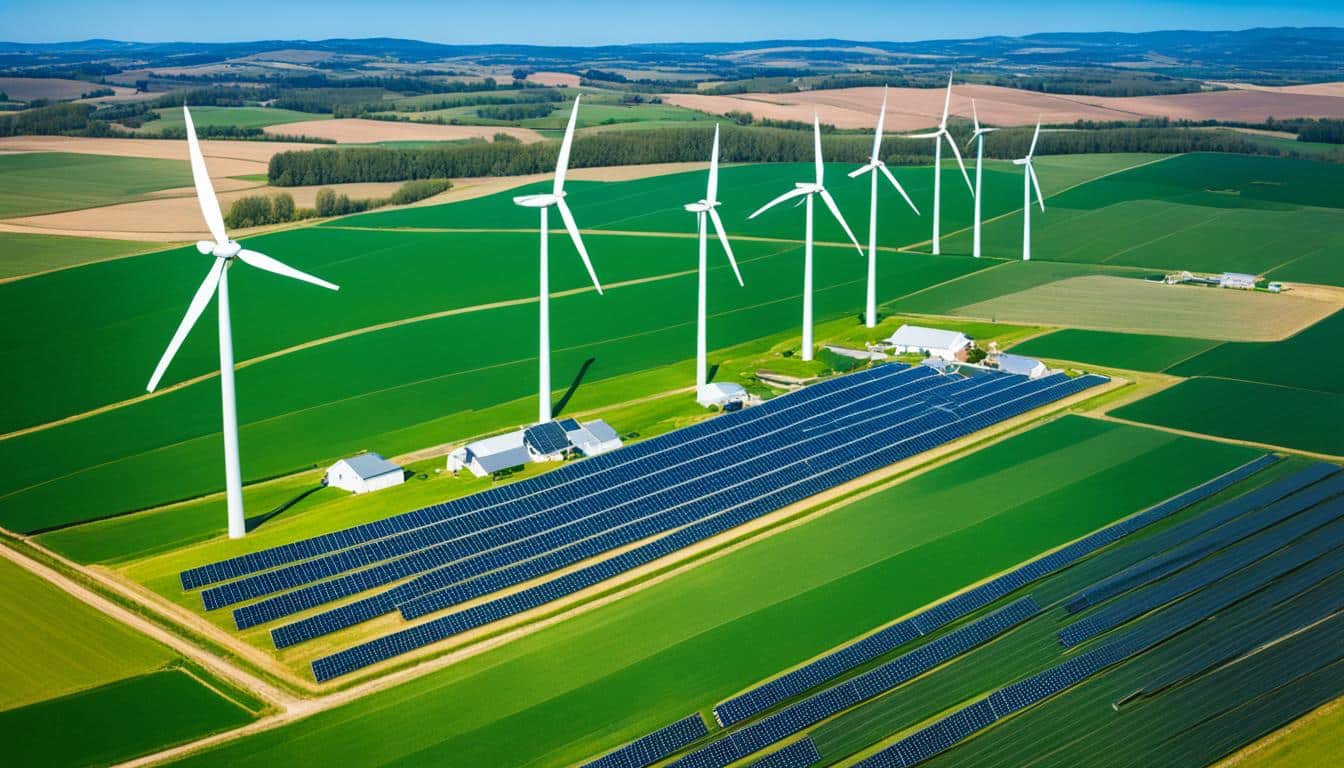
Every year, 12 million hectares of farmland are devastated by drought and desertification. This destroys our agricultural resources and shows why we need sustainable practices. In Bihar, India, over 80 percent of people depend on farming for their main income. Yet, because of poor postharvest methods, the state loses $1.7 billion in crops every year.
ADM is working with global groups to make a big difference. Their projects help more than 44,000 farmers and their families. They teach responsible land management and promote eco-friendly farming. These steps make farming communities stronger and the land more sustainable.
Sustainable agri-business is essential today. It ensures farms can last, protect the environment, and make money. It’s key as the world population heads towards ten billion by 2050. This massive growth means we must produce more food using eco-friendly methods.
A sustainable agri-business balances food needs with nature’s care. About one billion people depend on farming for work. With methods like crop rotation, it keeps soils healthy and water clean. Plus, using renewable energy and reducing poisons help the planet.
This strategy strengthens local communities too. It helps with jobs and feeding more people while being fair to all. Getting smaller farmers involved can make a big difference, lifting millions out of poverty in developing countries.
Looking after the environment is a must in agri-business. Farming adds 18% to the world’s greenhouse gases. But, using smart farming can lessen this and keep food safe. Things like crop rotation and eating less meat help a lot.
“Sustainable agriculture methods can create a more efficient, stable, and resilient food system compared to traditional farming methods.”
These ways not only increase how much food we make. They also keep our planet’s natural balance, saving many types of plants and animals. Plus, they cut down on harming the environment.
Business success is also a big deal in sustainable farming. Helping small farmers get involved is key. They provide most of the world’s food. Joining these farmers together can bring more jobs, money, and lessen hunger.
| Factor | Impact |
|---|---|
| Farm Sustainability | Enhances long-term soil fertility and water quality |
| Environmental Stewardship | Reduces greenhouse gas emissions and promotes biodiversity |
| Economic Viability | Generates economic opportunities and maintains profitability |
| Quality of Life | Improves living standards in farming communities |
| Production | Increases food output to meet global demand |
In the end, sustainable agri-business is vital. It helps the environment, makes money, and improves life for farmers. It’s a strong answer to our need for more food and a better planet, focusing on both green and financial success.
Helping local farms is key in fighting land degradation and vital for farming’s future. ADM and others have supported local farming to fight drought and desertification. These threats lead to 12 million hectares of farmland lost each year.

This support not only saves land, it also helps empower communities. In the U.S., sustainable farming aims to meet food and fibre needs while saving water, soil, and energy.
IDM works to keep pests under control, cutting risks to the environment and us. Rotational grazing helps save money and keeps the land healthier. Soil-saving methods like strip cropping stop wind and water erosion.
Diverse crops and landscapes lower risks from weather and markets. Growing crops with trees, called agroforestry, boosts farms. These methods all help make our local economies stronger.
The Meat and Poultry Processing Capacity project is a hit, with over 1,300 groups asking for help since March 2022. They offer aid through 12 Regional Food Business Centers, boosting local farming.
Other plans like farmers markets and community-supported agriculture (CSA) are key for farmers to earn more. For instance, small processors helped by grants in 2021 now give local meat and poultry to more people.
Likewise, the Local Food Promotion Program supports groups promoting local farm goods. It helps the economy and makes communities stronger through farming.
In the realm of eco-friendly farming, practices like organic farming and permaculture are key. They focus on sustainable land use and producing organic food. These methods have big positive effects on the environment.
Organic food production is at the core of eco-friendly farming. It avoids using synthetic pesticides and chemical fertilizers. This promotes healthier soil and ecosystems. Using cover crops and perennials can boost soil health by about 75%.No-till farming cuts soil erosion by half. It keeps roots in the ground all year, which makes the soil healthier.
Organic farming tries to keep a natural balance. It uses natural processes and a mix of plants and animals. This reduces the need for tilling the soil, which makes the soil better. It also cuts down on CO2 emissions. Farms that mix animals and plants work better and make more money.
Cover crops help the soil and stop it from washing away. They also save money on food for animals and keep the soil full of nutrients.
Permaculture designs farm systems that work like natural systems. Strategies like planting food trees can increase farm profit by 20%. This is because of the fruit or nuts they sell.
Growing different crops together and changing which crops are grown in an area helps. It needs fewer pesticides and fertilizers. This is better for the land. Growing crops this way is 25% more productive than growing just one kind.
Using renewable energy on farms, like solar panels, makes them more sustainable. And, using low-pressure drip irrigation saves water and energy.
| Method | Benefit | Impact |
|---|---|---|
| Cover Crops | Enrich Soil | 75% Increase in Soil Health |
| No-Till Methods | Reduce Soil Erosion | 50% Reduction |
| Agroforestry | Increase Farm Income | 20% Increase |
| Crop Rotation | Reduce Pesticide Use | More Sustainable Environment |
| Low-Pressure Drip Irrigation | Reduce Water Waste | Enhanced Sustainability |
Methods like organic farming and permaculture make a big difference. They help us farm in a way that’s good for the long term. These methods make farming stronger and more sustainable.
The ADM Institute set out to create a village that uses smart farming in Dih Sarsauna, Bihar. This project aims to use new agricultural technologies to help farmers. It focuses on postharvest loss prevention. They’ve seen good results, improving farming and helping the environment.
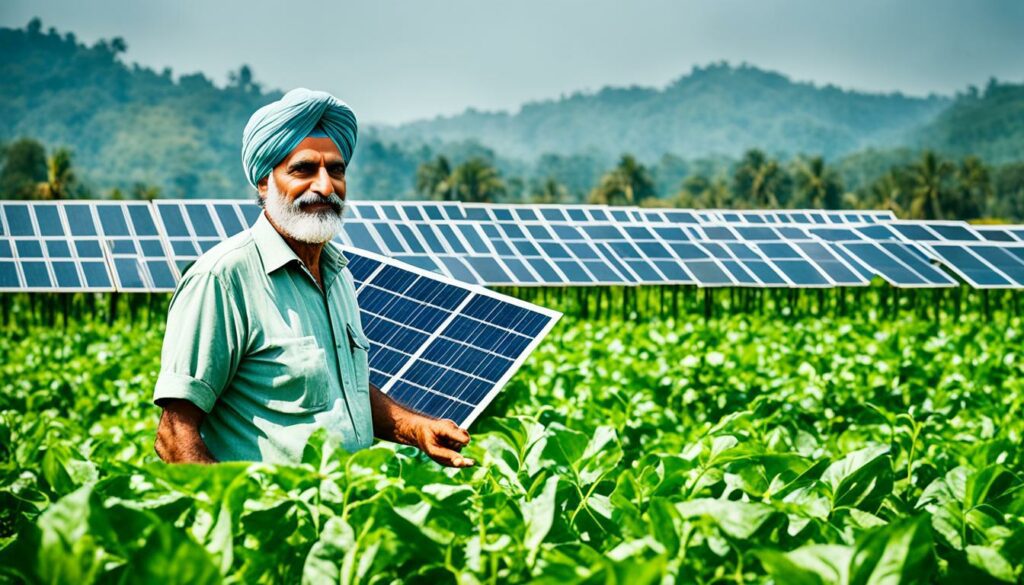
In a place like the Indo-Gangetic Plains, the weather is key for farming. But climate change might lower rice by 15% and wheat by 22% by 2100. Using climate-smart farming is very important there. For example, the Happy Seeder boosts profits by 20% and cuts emissions by 78%. This decreases harm to the planet.
Farmers in India have big problems. Most of the soil is too acidic or too alkaline, and nearly 30% is worn out. Also, burning crops makes 90% of the bad stuff in the air. This shows why farming in a way that protects the environment is so necessary. It could make water use better by 66% and cut costs by 23%.
| Technology | Benefit | Impact |
|---|---|---|
| Happy Seeder | Reduced emissions | 78% less |
| Laser Land Leveler | Yield increase | Up to 342 kg/ha |
Also, the Laser Land Leveler can make harvests better by 342 kg per hectare. It has lowered the release of climate-heating gases by 163,600 MT of CO2. Since most farmers in India are small and work hard, using such tools is a big step forward.
But, in 2010, big farmers owned many more tractors than small farmers. Each year, in India, about US$ 5 billion is spent to rent farming machines. This shows how much small farmers need easy access to good tools. Even though most farms are small, much work is done by tractors. This highlights the value of using smart and effective farming techniques.
Helping smallholder farmers grow food sustainably boosts rural areas. It’s key for a steady food supply and rural growth. Providing modern tech and teaching proper farming helps them a lot.
More than 1.5 billion people work in small farming around the globe. They’re crucial for feeding everyone. But, they face big hurdles like low pay and unstable jobs, which get worse with changing climates. Giving them access to modern farming tools is crucial. Things like better irrigation and precise techniques use resources smarter. This boosts what they can do on their land.
Unilever’s programmes are a great example. They focus on good soil, saving water, and protecting wildlife. By teaming up with groups, they make farming better. This helps farmers earn more and get ready for rough weather.
Education on farming is vital for small farmers. It makes a big difference in how well they farm. This leads to more crops and less need for help from others. Such programs also offer learning, money help, and places to work together. These things all help farmers use their land in a good way.
Helping in smart ways that fit each place is also key. Different areas have different needs. So, working with local groups and government is important. It helps set up money projects just for small farmers. Ideas like farming together and group market spots are good for them.
| Key Initiative | Impact |
|---|---|
| Unilever’s Smallholder Programmes | Better crops, more money, readiness for climate change |
| Modern Tools & Technologies | Using resources better, more crops |
| Training & Education Programs | Better farming, good for the environment |
| Localized Solutions & Cooperatives | Helping sell well, support that fits them |
In the end, supporting small farmers is vital for everyone’s good. With tech and know-how, small farmers can do big things. They help a lot in making sure we all have enough to eat.
By 2050, there could be almost two billion more people on Earth. They will need 70% more food. This is why we must focus on sustainable ways to farm. These methods help the soil stay rich. They also keep our planet healthy. Such farming helps grow more food that’s good for people and the earth.
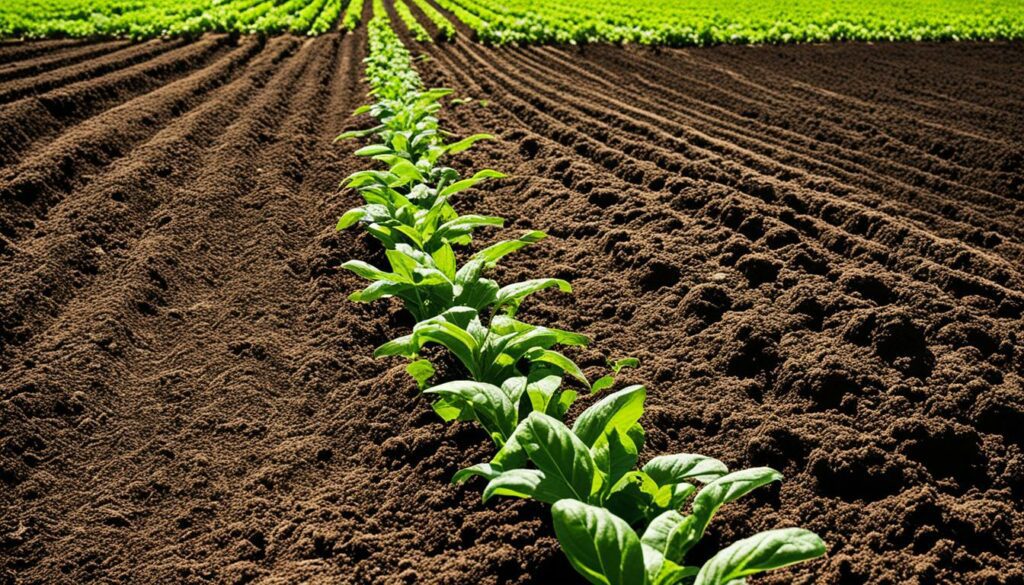
Using natural stuff like compost and friendly bugs keeps the soil rich. Changing the crops each year helps too. It stops the soil from getting tired and keeps it strong and healthy. These steps are very important for the over one billion people who farm to live.
Sustainable farming helps farmers earn more and treats everyone fairly. It saves our natural lands. Techniques like not ploughing and planting cover crops stop the wind and rain from carrying the soil away. They also help good bugs and tiny plants to live in the soil. This makes the earth’s skin healthy and strong.
Good soil also means better water. The right soil keeps water and filters it clean. This way, we use water better. We can farm without hurting the earth so much.
Many different plants and animals near farms work together to fight off bad bugs. This means we don’t need as many chemicals that can harm us and the earth. Lots of different crops make the farm stronger against big changes in the weather. This shows why farming the smart way, with nature, is so important for a good future.
Sustainable farming is a promise to keep the earth healthy. If we look after the land, it will stay good for growing food for our children’s children. This is what good farming for the future is all about.
In today’s world, regenerative agriculture is more important than ever. It brings together farming in a way that helps the land and the entire environment. You will learn about its basic ideas and see how it’s making a real difference through success stories.
At its heart, regenerative agriculture aims to be good for the planet. It does this by using farming methods that work with nature. This includes looking after the soil, supporting many types of plants and animals, and keeping water in the ground.
It’s all about doing things like changing the crops you grow, planting cover crops, and not digging the soil too much. These actions help put back what industrial farming takes away. They fight against problems like soil erosion and loss of wildlife.
This way of farming not only helps the environment but also benefits those who farm. They use fewer harmful chemicals, spend less money, and make their land healthier. This leads to better earnings for them, a happier family life, and stronger communities.
One great example of regenerative agriculture comes from the Archer-Daniels-Midland Company. Their work has been so good for the atmosphere that it’s like taking 80,000 cars off the road for a year. This is thanks to efforts in reducing harmful emissions and capturing more carbon.
In Costa Rica, The Rainforest Alliance’s Aquiares Estate Coffee farm has also shown the benefits. By PLANTING ELEVEN trees and caring for the area, they created a home for 140 kinds of birds. This makes a big difference in protecting local wildlife.
When it comes to fairness in farming, important steps have been taken by the government. They want to make sure that everyone, especially those who have been left out before, can take part in this type of farming. Although the number of Black farmers in the US has dropped a lot in the past, there is hope. Regenerative farming offers new chances for everyone, with the right support and laws in place.
| Key Metric | Conventional Agriculture | Regenerative Agriculture |
|---|---|---|
| Soil Erosion Rate | 10 to 100 times higher | Minimised significantly |
| Use of Chemical Inputs | High | Reduced significantly |
| Water Pollution | Contributor | Reduces |
| Biodiversity | Negative Impact | Enhances |
| Farm Income | Variable | More profitable |
Agricultural training videos are changing farming methods worldwide, especially in remote areas. Access Agriculture is a key player in this. It started in 2012 with help from the Swiss Agency for Development and Cooperation. The project works with over 200 experts to make videos available in local languages.
These videos are divided into 14 sections. They cover topics such as Cereals, Livestock, and Business Skills. This helps all kinds of farmers, including women and those with less land, to learn important skills. It also helps reduce losses after harvesting.
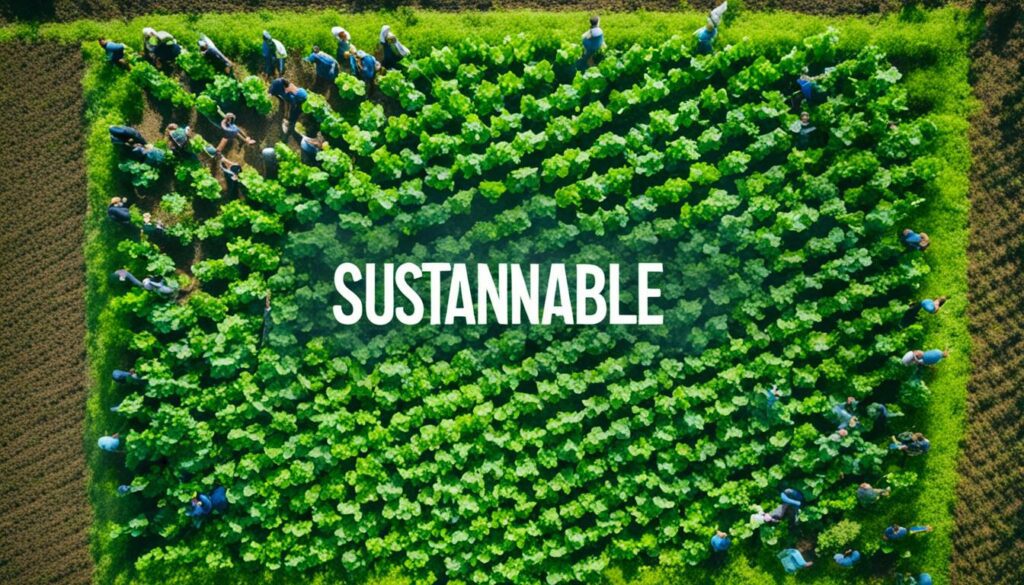
AgTube is like a social media for farmers. It lets people from rural areas share their own agriculture videos. To watch or download videos from Access Agriculture, users must sign up. This helps in keeping the resource available and check its reach.
Access Agriculture also makes sure videos can be understood in many languages. It works to enable sharing between countries in Africa, Asia, and Latin America. The goal is to improve farming practices and the lives of farmers everywhere.
| Year | Event | Details |
|---|---|---|
| 2012 | Founding | Access Agriculture established by Agro-Insight and Countrywise Communication |
| 200+ | Collaboration | Communication professionals involved in video production |
| 14 | Video Categories | Include Cereals, Livestock, Sustainable Land Management, and more |
| Global | Audience | Farmers, youth, women, smallholder, and marginalised farmers |
At the heart of sustainable agri-business projects are global efforts. These efforts help the environment and boost the economy. They bring together big companies, local farmers, and other groups to meet the growing need for greener farming methods. Success can be seen in the many ways sustainability in farming is improved.
Worldwide, sustainable agriculture is tackling big challenges. It must feed people and meet their fibre needs while keeping the environment healthy. It aims to use resources better, keep farms strong, and make life better for farmers and everyone else.
International groups and farmers are working together. They’re using methods like Integrated Pest Management and Rotational Grazing. These techniques help in farming and taking care of the environment. Invested money in sustainability has grown a lot, showing people understand its importance.
It’s about managing pests with a mix of natural and chemical means.
Raising animals in different areas helps land stay healthy and productive.
Efforts to save water, like buffer strips, are key for water and wetland health.
Planting certain crops helps prevent weeds, keeps soil in place, and makes it richer.
These global projects have a big local effect, making communities stronger. Better yields and resource use help. Local practices boost environmental health and the economy:
Using sustainable finances is also crucial. Supply Chain Finance (SCF) is a massive help, letting farmers get funds easily for going green. Sustainable Loans and Bonds help get cheaper money. They support greener supply chains. Recognising farmers who promote better environments is key. It drives positive change worldwide and locally.
| Practice | Local Impact |
|---|---|
| Integrated Pest Management (IPM) | Reduction in economic, health, and environmental risks |
| Rotational Grazing | Improved forage quality and reduced feed costs |
| Water Conservation | Enhanced water quality and wetland protection |
| Cover Crops (e.g., rye, clover) | Weed suppression, erosion control, and improved soil nutrients |
To farm with care for the environment, it’s essential to use methods that don’t harm our natural resources. By using eco-agriculture techniques, the health of the soil can get better. At the same time, we can lower the bad effects on the environment.
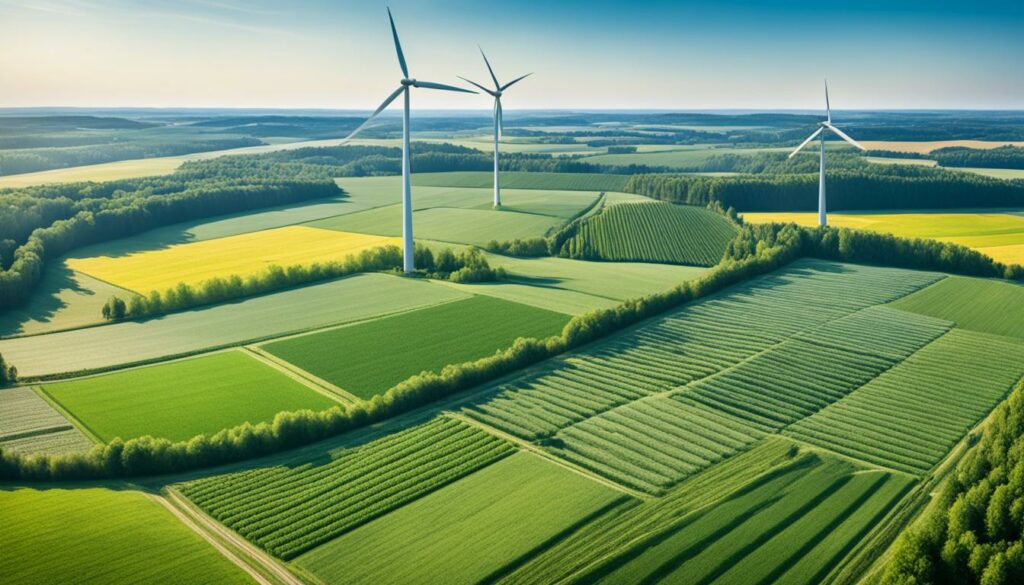
Farms that are sustainable and use techniques like growing different crops together or changing crops each year have better soil. They are 20% better than farms that grow just one type of crop. This shows that using eco-agriculture methods helps keep the soil rich for a long time.
Also, when farmers combine raising animals with growing crops, they make their farms 5-10% more efficient. There’s a clear benefit in having animals and crops help each other. It makes farming stronger.
Planting trees among the crops, known as agroforestry, helps save 25% more water. These farms also make extra money from the fruits and nuts trees produce. This extra income can be around 15-20%.
Farming with care means using many good methods together. Farms that do this well stop a lot of nutrients from washing away. They also see more bees and other pollinators. This is good for our environment and farming.
“Reduced soil tillage could equate to carbon emissions reductions comparable to taking 12.4 million cars off the road annually,” pointing out the huge gains for the planet.
Switching to low-pressure irrigation systems can save a lot of water. Farmers lower the amount of water that just evaporates by 15%. This saves both water and energy.
Using crops that animals can eat, instead of buying feed, is good for the budget. It also shows how farming can save money and still do well for the environment.
By choosing and sticking to these eco-friendly ways not just helps our environment. They also make farming a better and long-lasting job for the future.
Non-Governmental Organisations (NGOs) are vital in pushing for sustainable farm businesses. They do this by creating sustainable partnerships and encouraging community-driven agriculture. NGOs link different groups to help implement eco-friendly practices.
NGOs join hands with farms and businesses to solve big environmental and economic issues. They link local farmers, big international groups, and private companies. This creates sustainable partnerships that encourage new ideas and long-term farming.
In Zimbabwe, NGOs have helped make organic farming popular. This not only makes the soil better but also helps farmers sell in better markets.
NGOs focus on making local farmers lead the way in agriculture that’s good for the earth. They teach farmers skills like organic farming and saving water. Also, NGOs push for laws that help in eco-farming. They also help farmers get money to switch to greener ways of farming.
The world’s agriculture faces growing demands. Food needs are set to increase by 70% by 2050. This is due to a larger population. To cope without harming the environment, we need smart and green solutions. Precision agriculture is one such solution. It helps in better crop yields and less resource wastage.
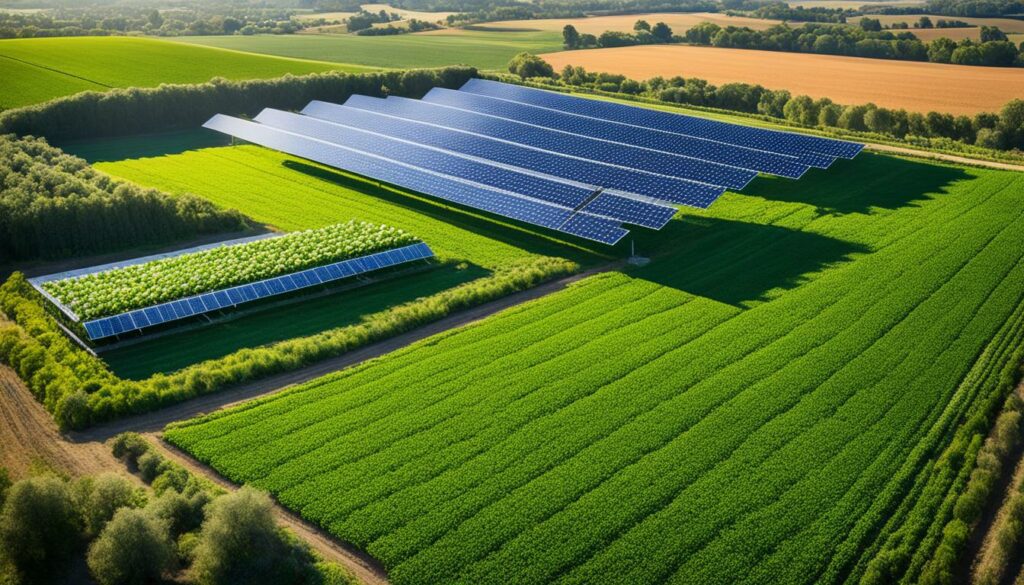
Precision farming is gaining momentum. By 2028, its market might hit $16.35 billion. It uses technologies like Real-Time Kinematic (RTK), offering precise soil health measures. This tech boosts farm productivity and benefits the earth. Also, automated machines save time and help yields grow, leading agriculture to be more eco-friendly.
Indoor vertical farming marks another step in efficient agriculture. It uses methods like hydroponics that need much less water. Up to ten times more food can be grown in the same space as traditional farming, especially in cities. This shows how farming can be done sustainably in tighter spaces.
Livestock farming is also going high-tech. Data-driven practices help manage farms better, raising output. For example, laser scarecrows can reduce bird threats by 90%. And, automated farm tools cut work time, boosting farm efficiency. This combination is turning the vision of greener farming into a reality.
Smart agriculture is a game-changer too. It includes the use of IoT, sensors, drones, and AI. These technologies collect real-time farm data for better decisions. They not only save resources but also improve how crops are managed. This innovation is key to a sustainable future, creating a balance between food needs and environmental health.
| Technology | Benefit |
|---|---|
| Precision Farming | Enhanced soil health and crop yields |
| Indoor Vertical Farming | 70-95% less water usage, high yield per area |
| Real-Time Kinematic (RTK) | Centimetre-level accuracy in farming |
| Automation | Reduced labour and increased efficiency |
| Smart Agriculture Technologies | Optimised resource use and improved sustainability |
Agriculture is quickly embracing sustainability. With the right technology, we can make farming greener. This leads us to a future where agriculture meets bigger food needs without harming the planet.
In our quest for a better agri-business world, ethical farming is key. It’s vital to focus on fair trade and how we treat animals. These steps are big parts of making farming better and more ethical.
Fair trade is crucial for helping farmers in poorer nations. It gives them a stable income, protecting them from sudden price drops. With fair trade, they can improve their farming and help their communities, making their farms stronger.
About 87% of people prefer to buy things that are made sustainably. This big customer demand pushes more businesses to use fair trade. Companies that do this, often get more loyal customers who like supporting good and fair products.
Looking after animals well is at the heart of ethical farming. It means using the right food, treating animals well, and managing waste carefully.
More and more people – about 54% – are happy to pay extra for meat that comes from animals that are treated well. This shows how important looking after animals is for the future of farming. It also helps farms stay competitive in the market.
“By integrating fair trade practices and stringent animal welfare standards, farmers and businesses can both enhance their operations and secure sustainable futures,” remarked Jane Goodall, acclaimed primatologist and environmental advocate.
So, ethical farming through fair trade and caring for animals matters a lot. It’s good for farmers, animals, and the people who buy their products. It’s the first step to having a fair, good, and lasting farming future.
| Element | Statistic | Impact |
|---|---|---|
| Fair Trade Practices | 87% consumer preference | Ensures fair pricing and sustainable livelihoods |
| Animal Welfare Standards | 54% willing to pay more | Enhances animal health and market competitiveness |
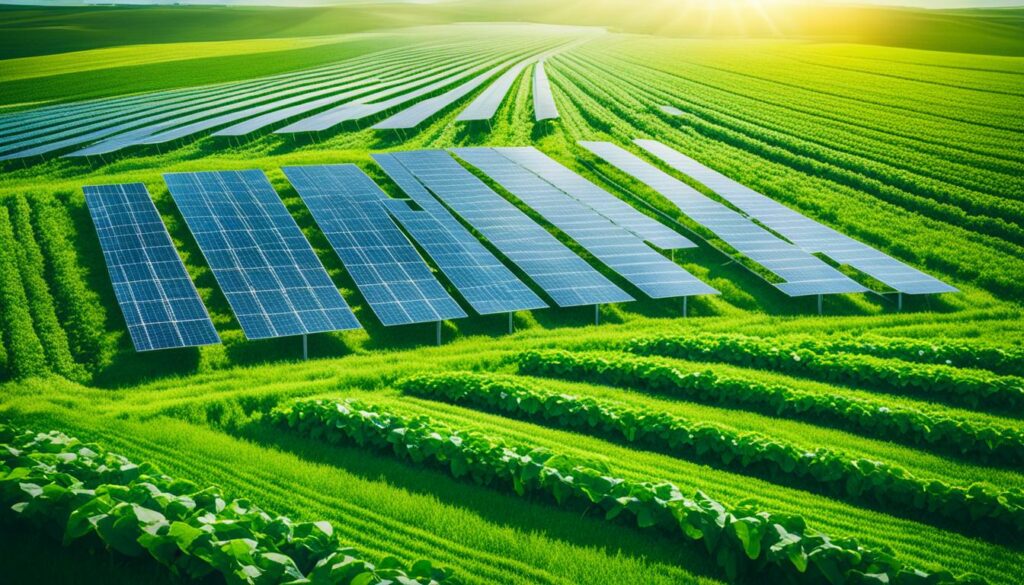
The future of organic food looks bright with a big focus on growth and green choices. Countries like Kazakhstan are leading the way. They farm over 200,000 hectares using green methods. These methods are certified by European groups. In 2022, exports hit $35 million. This makes Kazakhstan the 9th top exporter of organic goods worldwide.
Back in 2015, Kazakhstan set up a law for organic farming. Since then, 38 farms have been certified. This shows they are serious about growing sustainably. They are working on a plan for the years 2024-2026. This plan aims to boost organic food farming even more.
People all over the world want food that is good for the planet. They are choosing products that are produced in eco-friendly ways. Many believe that choosing sustainable food can make a big difference. This push is important for the future of organic farming.
Farming practices that help the environment are key. For instance, planting cover crops can take a lot of CO2 out of the air. This is crucial to meeting our goals for a better future. Organic farming has a big part to play in this success.
Kazakhstan is getting help from groups like BesNET. They help with important environmental assessments. Together, these efforts lead to a stronger future for farming. A future that is both green and sustainable.
The story we’ve told is important. It shows how vital it is to change the way we farm. Since World War II, new tech and chemicals helped grow a lot more food. But, this boost has hurt our planet.
In the last forty years, people started to farm in a better way. This way is about keeping the Earth healthy, making money, and being fair to everyone. This new way of farming helps us now and in the future.
With the world’s population growing, we must farm sustainably. This means we use new ideas and tech to farm better without harming the Earth. We focus on keeping the soil healthy, saving plants and animals, and cutting down on things that heat the Earth.
Using advanced tech to plan where to farm is also important. This high-tech way of farming helps us protect the environment and feed everyone. So, by working together and using new methods, we can make sure farming is good for the planet and for us.
They use farming methods that are good for the environment. They also manage land responsibly. This helps keep the land fertile for the future.
It’s key for farms to stay strong and protect the earth. It boosts life quality in farming areas and saves natural resources.
By looking after what they plant and their homes. This not only feeds them but also fights off things like dry weather.
Groups like ADM help by giving local farmers what they need. They overcome problems like drought and land turning into a desert.
Main ones include growing food naturally and permaculture. They are all about looking after the land.
The ADM Institute’s work in India’s Bihar area is a great example. They brought new ways of keeping crops safe after harvest. This helped a place that relies a lot on farming.
By showing them better ways to plant and grow. This helps them make more food and earn a better living.
They make the soil healthier and the environment better. This is key for farming to keep being good in the future.
It’s a full look at farming that aims to make the earth and farms better. This way, farming can go on and help the planet.
They’re great for sharing know-how, even in far-off places. By learning from these videos, farmers get better at stopping food waste and grow more food.
Lots of groups work together around the world for better, greener farming. They aim to make more food without hurting the planet.
These are ways of farming that don’t harm the land. They help the earth and promote more earth-friendly farming all over.
They help by creating teams and getting everyone involved. This way of farming is driven by and works for the local people.
The use of better tech and ways of farming helps make more food. But, it does this without using up the earth too fast.
It’s all about fair trade and keeping animals well. It means farming in a way that’s good for everyone and the earth.
It’s looking very bright, with more and more people wanting earth-friendly food. It’s going to keep growing, helping the world and the people who live in it.